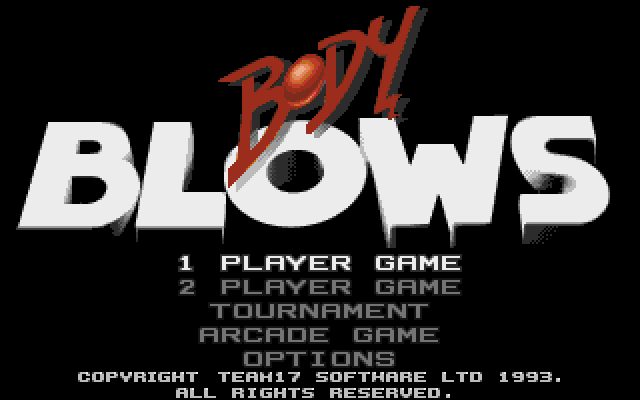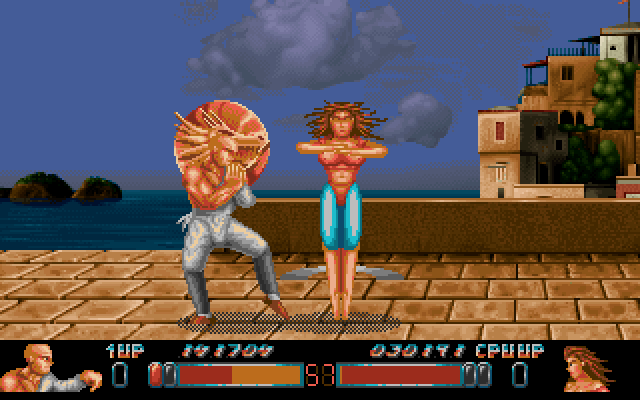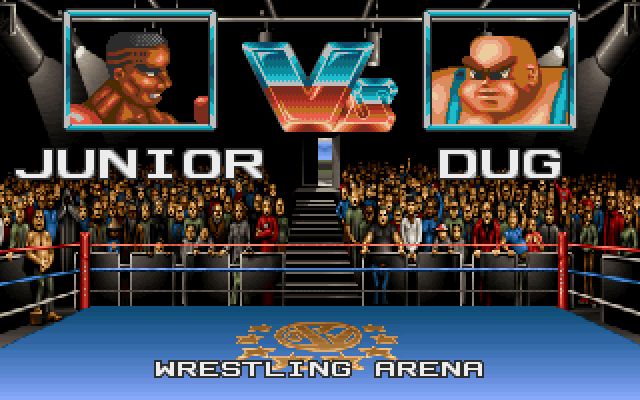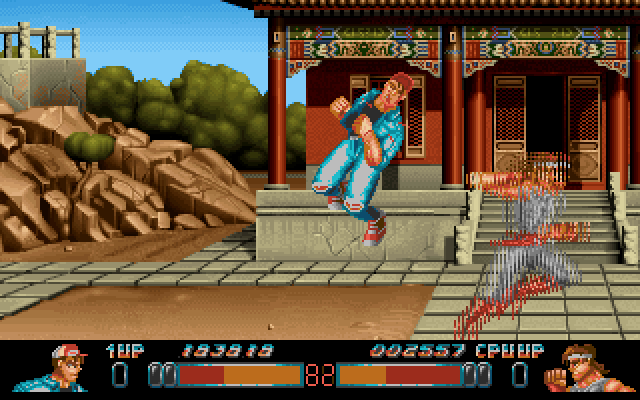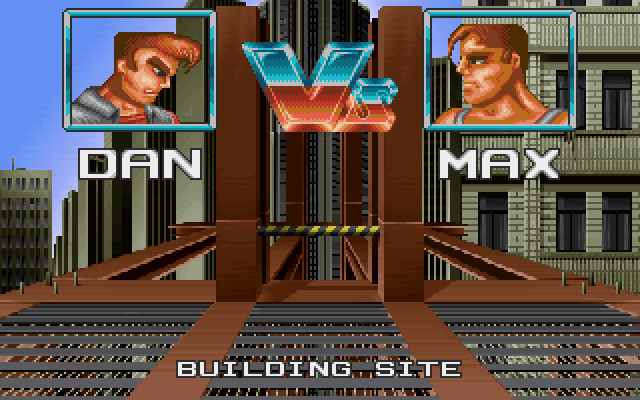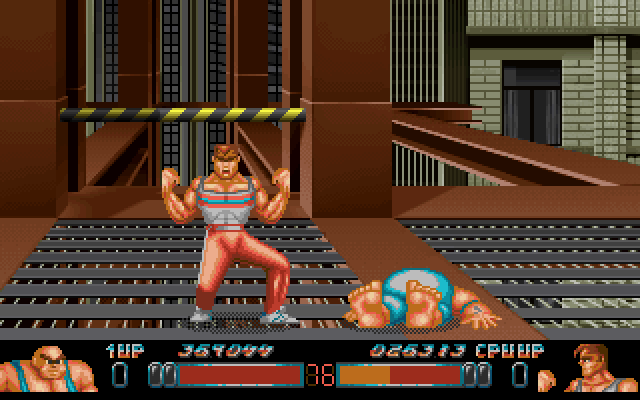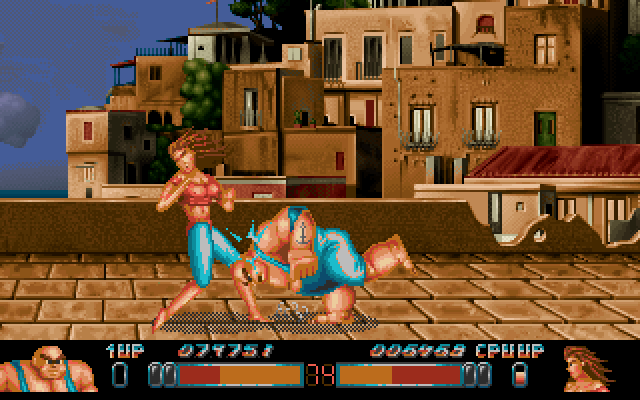 by: Wes
by: Wes
There was a time when I considered myself to be a dedicated console gamer. I subscribed to EGM, Game Informer, and PSM; read those and other magazines as well as various websites in order to keep up with the latest gaming systems and game releases; and -- while I generally waited until games got older to actually buy them in order to get them at bargain prices -- frequently rented new titles from Blockbuster. Ever since I discovered DOSBox and D-Fend, however, I've hardly been interested in the latest games. Sure, I could spend hundreds of dollars on a PS3 and more recent titles with fancier graphics and film-quality cutscenes, but why do that when I can browse abandonware sites and revisit computer games from my youth for free? I was a DOS gamer before I ever had a console system -- my first console was a SNES and I didn't get that until 1993 -- and those older, classic games still hold more appeal for me than most newer titles ever could.
Team 17's Body Blows is a fighting game that I (mostly) remember fondly, but a true classic it is not.
We'll get to the reasons that Body Blows probably shouldn't appear on a list of anyone's top PC fighters in a bit, but first let's talk about the things that made it memorable. In a day when even many console fighting games had barebones options menus that consisted only of joystick/keyboard configuration, sound, and occasionally difficulty and round time options, Body Blows had one of the most customizable menus I'd ever seen. Per the image above, players could set the round time -- with with options of 60, 90, or unlimited seconds, unlike the simple "time on/off" option in most fighters. They could set the number of rounds, a rarely seen option. Heck, players could even enable mirror matches -- which was also pretty impressive considering that console fighters were just getting around to allowing them. (It's an option we generally left off, but still.)
There were even the unique "mercy" setting and options related to the tournament mode, the latter of which was also impressive considering that very few fighters even had tournament modes in 1993. (What ever happened to tournament modes, anyway? It seemed like every other fighter had them a year or so later... and then they all but vanished in next-generation titles. Huh.) Speaking of modes, players could select the standard 1- and 2-player games and tournament mode as well as an "arcade" mode. The arcade mode was pretty much the same as the 1-player game with a limited character selection roster -- players could only choose the game's four "heroes" instead of all of the non-boss characters -- but players did get an ending if they won! That's if they won... which they probably wouldn't have with any of those characters. But hey, there was even a secret cheating menu to help players out in that respect.
The game also had a roster of ten playable characters and one unplayable boss -- again pretty respectable for a fighting game of the day -- even if the character designs were pretty uninspired. Players could choose from Nik, the game's ostensible "hero" with a familiar special moveset; Dan, Ken to Nik's Ryu (or vice versa); Junior, the obligatory black boxer; the Shaolin monk Loray; Dug, a fat bum from the streets of Vegas who just happens to be the best character in the whole damned game; the electric-powered Russian Kossak; the Spanish hottie Maria; Yit-U, some sort of speedster monk guy; Ninja, the most aptly (if boringly) named character ever; Mike, a cyclone-powered businessman who gleefully checked his watch and apologized at the end of every round; and Max, the game's cheap-as-all-bloody-hell final boss with a terrifying second form.
Body Blows even had a fairly interesting (though not terribly unique; Teenage Mutant Ninja Turtles: Manhattan Missions and other games of the era had similar setups) control scheme designed to accommodate players using either a keyboard or a (one-button) joystick. Instead of featuring separate punch and kick buttons and requiring players to tap out motions on the directional buttons to pull off special moves, Body Blows only had one action button and eight directionals -- and to attack, one simply had to hold down that button and press one of the directional keys. Blocking was accomplished by holding the button and pressing back, and even special moves were performed by holding the button and pressing certain directions, usually up-toward or up-back. Each character also had a special move that could be performed by holding down the action button for two seconds. Considering how finger-numbing PC fighting games like Street Fighter II and Sango Fighter could be for keyboard players, I very much appreciated this scheme back when I didn't own a joypad.
Hell, even the graphics and sounds were pretty impressive. The characters were large, colorful, and sported nifty details like the anchor tattoos on Dug's arms, the holes in the knees of Nik's jeans, Ninja's various ninja straps... and Maria's large breasts and visible nipples. The game's backgrounds were similarly detailed, with the rich rock structures, Buddha statue, and ancient temple glimpsed in Ninja's Ninja Caverns (seriously) and the cloudy skies and sleepy buildings of Maria's stage in Costa Rica (which is incidentally nowhere near her home of Barcelona, Spain, but maybe she moved just after registering for the tournament). And I rarely have lots to say about sounds unless they're really awful, but the grunts, smacks, and screams of Body Blows enhanced the play experience despite being fairly standard stuff -- and the intelligible win statements and catchy tunes were definitely among the better sound effects from PC fighters of the day.
And then the gameplay had to fuck everything up. Yeah, the characters of Body Blows had varied movesets and cool specials, but there wasn't any real technique involved in the fighting -- despite the non-traditional control scheme, it was basically a button masher. The lack of any notable lag time after missed or blocked moves or stun time following successful attacks largely stripped the game of any strategy, such that fights quickly devolved into back-and-forth slugfests from which the strongest character emerged victorious. And since that character was easily Dug -- a problem compounded by his devastatingly effective specials -- my friends and I outlawed the use of him during the few times we dipped into the 2-player mode for head-to-head action. We also rarely made use of the mirror match option because, whereas other fighting games that allow such fights usually change characters' outfits or colors in order to distinguish the players, Body Blows used the same palette for each player... which could make it pretty difficult to tell who was who in the thick of action. I've just noticed that there's text at each fighter's feet designating which fighter belongs to which player, but it's kinda hard to see since it shows up behind the characters rather than in front of them. More often than not, we decided that it was better to just avoid that confusion altogether.
But PC fighting games of 1993 often seemed more suited to single-player action -- dual joystick setups were rare back then, and two players huddled around a keyboard, while doable, just wasn't all that convenient or comfortable -- and here Body Blows faltered even more because the computer was a cheating bastard. Part of that was because of the brokenness of the game itself, as any fight against a character stronger than your own was already going to be doubly difficult, but the game ramped up the challenge by making the CPU able to do things players couldn't. Remember those two-second charge special moves I mentioned earlier? Whereas players had to stand completely still for two seconds without getting hit in order to execute them, the computer could do them on the fly -- busting them in players' faces immediately after they'd successfully connected with attacks and even working them into makeshift "combos." Seriously, if you watch the recorded videos, pay attention to how quickly the CPU's charge gauge rises and falls during battle. It's insane.
And remember that "mercy" option? It ostensibly prevents one from charging a special move or setting up an attack until a downed opponent stands back up -- but it truly earns its name against the CPU because unless you have it enabled the CPU will mercilessly attack such that players stand up into moves with no chance of defending. For instance, Dug's charge special involves him stomping the ground such that it shakes and causes damage... and without the "mercy" option enabled, a CPU Dug can execute a knockdown move and follow it with his charge special fast enough to juggle players when they hit the ground. It's so unbelievably fucking cheap that I'd turn off the mirror match option and pick Dug just so I wouldn't have to fight him -- but then I started picking Dug because I realized that he's the only character who has a freaking chance against the stronger CPU opponents. Even counting the hours I spent revisiting the game before and while writing this review, Dug is the only character with whom I've ever fairly (that is, without cheat codes) beaten the game.
And in the event that players could defeat Dug -- and Kossak; he was hella strong and pretty damned cheap too, what with his powerful charge move that hit once when he drilled into the ground and again when he came back up -- without using up all three of their continues, they'd ultimately reach another nigh unstoppable challenge in Max, a boss who made SNK bosses seem tame by comparison. Sure, his moves didn't do 50+% damage, but he had the ability to launch them so quickly that players couldn't defend against them and had almost no chance to counterattack. And if, by some chance, players did find themselves actually trading blows with Max, they'd find that to be a losing proposition -- since Max had extremely high defense, it'd take roughly two of the players' more powerful special moves and (even more regular attacks) to equal one of Max's basic attacks. And whereas SNK bosses at least had some fatal AI flaw that could be exploited, any effective line of attack against Max was unsustainable due to the sheer amount of punishment he could take. Honestly, aside from cheat codes, I only know of one way to beat Max, and it predictably involves playing as Dug. Even then, as you see from the rightmost image above, winning that slugfest is not guaranteed.
But that's not even the best part. If players happened to evade Max's freaky rush combo punch, avoid getting knocked down (and, unless they enabled the "mercy" option, thus avoid the fireballs he'd shoot at opponents while they were down), and actually score the zillions upon zillions of hits required to reveal the chink in Max's armor, they'd discover a surprise: the criminal emperor Max is actually a fuckin' Terminator. He did look a bit like Arnold Schwarzenegger before, didn't he? Anyway, with Max's Skynet heritage thus revealed, players would have to defeat him again -- and this time he'd be able to fire missiles and extend his limbs and do all of the wicked cool shit a robot cybernetic organism who's pretending to be human can't do because doing it would give away the secret secret he's been hiding under his skin. The good thing about Max's T17 form (like the company's name, Team17 -- how cute) is that it's exponentially easier than the initial battle against him. Sure, using Dug practically guarantees a win, but I just fought him fairly with Ninja for the first time ever and took him down with relative ease. The bad thing about Max's T17 form is that you've got to beat the living tissue off of him to get to it. And unless you're playing as Dug, good fucking luck with that.
And whereas players would get a bonafide ending if they managed to defeat both of Max's forms with one of the four losers heroes in arcade mode -- an ending with terrible grammar and comma splices, but an ending nevertheless -- the only real reward for beating Max in the standard 1-player game was the opportunity to leave their names on the high scores list... provided their scores were high enough. But since they'd also get to sign the list with a qualifying score even if they used all three continues and lost the game, all beating Max was really worth was bragging rights. And since nobody who was anybody played Body Blows and gave a crap whether a player had beaten Max or not, it didn't really mean a good goddamn either way.
I'd love to be able to link you to an abandonware site where you can download Body Blows for yourself, but apparently Team17 representatives contacted them all and requested that their games be removed. In truth, it's not such a big loss -- unless you enjoy being forced to play as one character in order to have even half a chance at winning, you probably wouldn't have had too much fun with the game. If you're still curious, though, you can check out the videos I've uploaded to my YouTube account! (In case you hate YouTube and/or would rather view the higher quality Xvid encodes, I have those larger files available for download too.) Seriously, it was a cool game in a lot of ways -- the options, graphics, and sounds were fairly impressive given the time period -- but a fighting game needs fun, balanced gameplay; characters on relatively equal footing; and challenging yet fair CPU opponents in order to be truly enjoyable. Body Blows not only lacked these things, but took asshattery to even greater heights: to add insult to injury, the game would make players watch the CPU rack up bonus points for killing them in a given round. If that's not bastardly, I don't know what is.
-- Wes --To see Body Blows in action, click the following links! Whereas the video descriptions will take you to the corresponding videos on YouTube, you can download the Xvid encodes using the links in parentheses. (Just right-click them and select "Save Link As...")
| Maria vs Ninja (4.78 MB Xvid avi) | Dug vs Kossak (5.42 MB Xvid avi) |
| Loray vs Junior (5.32 MB Xvid avi) | Ninja gets owned by Max (4.09 MB Xvid avi) |
| Ninja gets brutally curbstomped by Max (5.23 MB Xvid avi) |
| Dug defeats Max in both forms (16.4 MB Xvid avi) |

